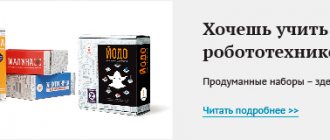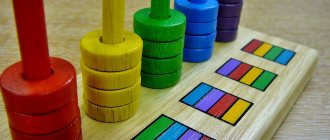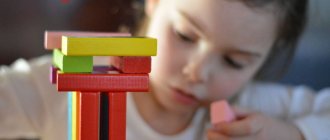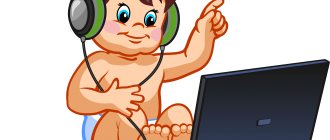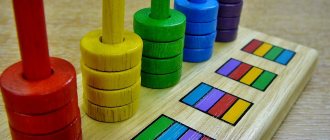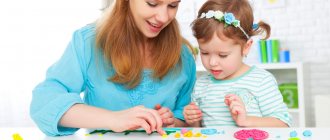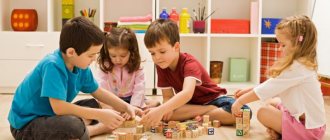Features of the development of thinking in preschool age
Children's thinking is characterized by a qualitative originality that distinguishes it from the thinking of adults. The development of thinking in preschool age is included in subject-related activities. A preschooler gains knowledge and experience through actions. These actions develop into ready-made schemes, are appropriated by the child (internalized) and become the basis of intellectual activity.
But the child not only uses ready-made connections that are familiar to him from actions with objects, but is aimed at establishing new relationships for him. A preschooler doesn’t just try on construction kit parts; selects a suitable object to “feed” the doll; builds a garage for his car - all these actions require analysis, comparison, generalization. That is, the child thinks, reflects.
The formation of a preschooler’s speech skills has a tremendous impact on the thinking process. Speech arises from the child’s need to communicate and interact, and then it acquires the functions of thinking.
In the first years of life, adult speech helps the child organize thinking and keep it in accordance with a specific goal. “Which ring in the pyramid will be next? Is it suitable? - the mother asks questions to the baby, and in response he tries to understand why one ring fits and the others do not.
The formation of active speech of the preschooler himself rapidly changes the conditions for the development of thinking. Now the child can ask a lot about what piques his interest. And the appearance of numerous questions is not long in coming.
Receiving answers, the baby finds out hidden characteristics and connections of objects that are not obvious to him, and children's thinking acquires elements of criticality and planning.
From younger to older preschool age, the internal mechanisms of the thinking process change. If in a small child the thought process is triggered by actions, then after 5 years a preschooler begins to actively operate with images.
Types of thinking
Psychologists distinguish the following types of children's thinking:
- objective-active
- up to two years, develops mainly from “spurring” by imagination, the baby examines, disassembles and even breaks toys and household items, but cannot yet explain his actions; - visual-figurative
- from two to four years, appears on the basis of the child’s existing knowledge, the child already understands some images and can use them in the game, for example, plays “to the hospital”; - verbal-logical
- from four to five years and older - depends on the development of speech, which is actively used by the child in play and everyday life; - abstract-symbolic
- develops at the same age, when the child is able to identify some features and signs of things.
Creative thinking is highlighted separately, and it does not depend on the age of the child: both a two-year-old child and a schoolchild can build towers from cubes or practice with a construction set, draw, sculpt, sing and dance.
Basic forms of thinking of preschoolers
The famous researcher of child intelligence, Jean Piaget, defined the entire preschool age as a stage of specific operations. However, this stage does not end with the child entering school, but continues until the age of 11.
While living through this stage, children first gain the ability to build mental representations of objects and phenomena through actions. Then they discover the ability to imagine images and act with them internally. And almost on the threshold of school, they discover the ability to think logically.
Accordingly, from an early age until entering school, one can observe how the types of thinking in preschoolers consistently develop with the dominance of the most characteristic of their age:
- Visually effective
- Visual-figurative
- Verbal-logical
Each subsequent form of thinking does not displace the previous one. At each age level, the child thinks both in the way he is accustomed to and adds new approaches.
Visual-effective thinking
Once again, we emphasize that the development of a child’s thinking is triggered by action. “I do - I observe what I do - I begin to understand something” - this is how the mechanism of the simplest thought processes works. Therefore, it is called visual-effective thinking.
The baby’s mental attempts are tied to visual situations and reflect direct relationships between objects. For example, when scooping porridge with a spoon, almost every child intentionally or accidentally turns the spoon over so that the contents fall onto the table. This simple experiment allows him to understand how to use such cutlery.
The next discovery will be the shape of the spoon. It turns out that you can’t do without the concavity of this tool if you want to eat soup.
Thinking for a 3-4 year old child means performing certain actions and observing what is happening, and not remembering and reflecting.
Thus, gradually, visually effective thinking is formed as the discovery of subject connections - between the components and characteristics of one object, between different objects, etc. Thanks to the accumulated experience, the child’s type of thinking acquires important characteristics:
- abstraction
- generality
Distraction is manifested in the fact that the child identifies an important feature and begins to use objects variably. For example, a plastic disk has just served as the steering wheel of an imaginary car, and now a preschooler is using it as a plate from which he feeds a doll. In this case, the shape of the object tells the child how to use it.
Generalization of thinking lies in the use of the same object for different purposes. For example, a younger preschooler can put small toys in a bucket, and then shake everything out and try it on as a headdress or use it as a chair.
Visual-figurative form
Experience in practical actions is an indispensable step for the development of the next type - visually imaginative thinking.
Productive activities are especially useful for developing creative thinking. When intending to build, sculpt or draw something, a child at least vaguely imagines the result. This already contains an intellectual task: “I want to do it... But how can I implement it?”
What features should you focus on to draw an apple? Probably on its round shape. And to make it even more similar to the original, you should add a ponytail with a leaf.
The preschooler draws models of the objects he sees around him. And this is only possible if he notices important characteristics of objects, analyzes, establishes differences and similarities with other objects.
An important feature of visual figurative thinking is that a child can imagine a certain object and come up with its image using memories and using imagination.
This implies the main properties of the figurative form of thinking:
- mobility
- structural organization
Thanks to the mobility of thinking, a preschooler is able to supplement his ideas. It is enough to show the baby the long ears of the toy, and he will immediately recognize the hare. This property extends to the child’s recognition of any objects familiar to him by visible elements.
The structural organization of mental activity is clearly manifested in design. To build a model from structural parts, the child thinks about the relative position of the parts and determines the sequence of connections. Thinking, he looks for ways to create an image that would correspond to the plan.
Role-playing games effectively develop children's imaginative thinking. It is in such games that preschoolers try to create typical images, analyze and mentally imagine situations that truthfully reflect real life or correspond to fantastic plots.
Visual-effective and visual-figurative thinking are closely intertwined. The child is driven by cognitive activity. He experiments, and thanks to actions and images, he discovers relationships, signs, characteristics, features in the world around him. These types of thinking bring the preschooler closer to understanding objective logical laws.
Mental operations
Observing how a child’s thinking develops, the entire thought process can be divided into stages:
- comparison;
- analysis;
- synthesis;
- generalization.
At the comparison stage, the child learns to find the same in different things, different in the same. During this period, it is appropriate to give “find the differences” pictures and play memory games (start with 6 pairs of pictures, gradually increasing the number).
At the analysis stage, features, qualities, properties, materials and objects used are identified. In his imagination, a child can divide any product into its component parts.
The synthesis stage is closely related to the analysis stage. Without analysis it will not be possible to synthesize. An example of this is reading. Without remembering letters, without understanding how they merge into syllables, a child will not be able to read.
Vivid signs of generalization are the identification of common characteristics of objects and grouping. As soon as a child develops coherent speech and the use of a large number of generalizing concepts, you know that the generalization stage has begun.
Games and exercises for the development of imaginative and logical thinking
- “What does it look like?” Show your child a picture of a fancy blot. Let the child come up with as many original associations for it as possible.
- "The fourth is odd." Invite your child to look at 4 pictures, three of which can be combined according to some characteristic. The child must understand which picture is “extra” and explain why he thinks so.
- “Call it in one word.” This game consists of an adult offering the child a set of words or images that can be combined into a concept. The child’s task is to name objects in one word (for example, tit, nightingale, woodpecker, crow, hawk - birds; raspberries, gooseberries, strawberries, watermelons - berries).
- “Put it into groups.” An adult places pre-prepared objects or their images on the table and mixes them. The preschooler must sort them into groups according to some characteristic.
- “Fold the picture.” This didactic game is an analogy to puzzles. The child’s task is to put together a whole picture from several parts.
- "Sudoku". This puzzle, popular all over the world, in its simplified version (2x2, 3x3 or 4x4), is also suitable for preschoolers.
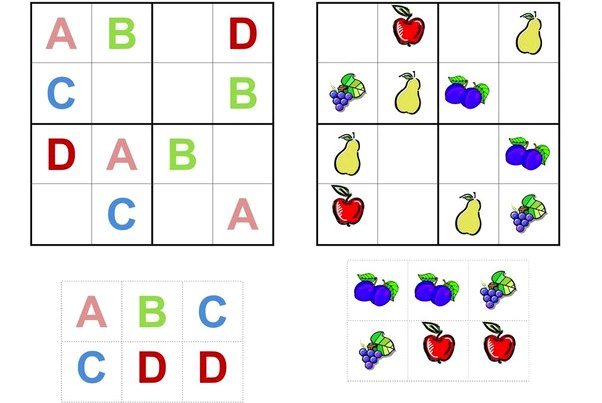
- “Who eats what?” Select pictures depicting animals and their favorite delicacies, mix them, and then ask the child to make pairs (feed the animals). By analogy, you can play games such as “Moms and Their Babies”, “Who Lives Where?”, “Signs of the Seasons” and so on.
- “Continue the row.” Draw long beads and start a sequence of bead colors (for example, red, yellow, blue, red again). The child must color the rest of the beads, following the pattern.
To make it interesting and fun for your baby, try to introduce your child to new games and exercises every time.
- "Opposites". In this game, the child needs to come up with a word with the opposite meaning. For example, you say the word “big”, and the child says “small” (“cheerful” - “sad”, “loud” - “quiet”, “fast” - “slow”, and so on).
- "Guess what it's about." This game will help develop not only thinking, but also attentiveness. Describe one of the objects in the room, and the child must guess what it is about. For example, a fragile, glass, beautiful vase.
For other useful games and exercises, watch the video:
Board games (checkers, chess, strategy games), mazes and puzzles are also suitable for developing the thinking of preschoolers. Such games allow kids to learn how to make decisions, think through moves, and assess possible risks. Role-playing games, communicating with peers, reading and discussing books are also great for developing creative thinking.
